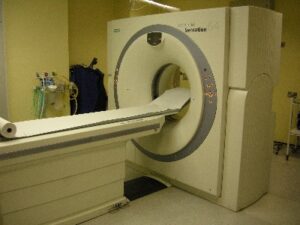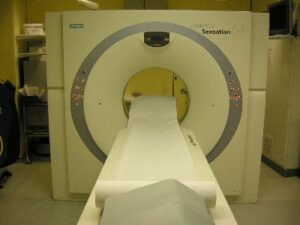- 0044 (0) 207 351 8754
- [email protected]
- Royal Brompton Hospital - London
A CT (computed tomography) scan is an advanced type of x-ray which gives fine details of the structure of the lungs and airways. The CT scanner uses x-ray equipment to take detailed, cross-sectional images of the inside of your child’s body. The CT scanner itself is a large machine with a hole in the center, which has the appearance of a large doughnut. The child lies still on a table that slides into and out of the center of the hole and the machine takes pictures of small sections of the body that require investigation. You can assure your child that although the machine is large and makes “funny noises”, it will not touch them during the scan. It is usually quite quick – just a matter of a few minutes. It is completely painless but your child must lie very still, so depending on their age they may need some sedation. Occasionally a small amount of fluid (contrast media) needs to be injected into a vein for the procedure, but you will know in advance if this is going to be necessary.

Example of type of details shown on a CT chest scan
Although CT studies require the use of ionizing radiation (x-rays), the amount of radiation used is minimized by advanced CT detectors and computer technology, which achieves the best image quality at the lowest possible radiation dose. Also, protective shielding is applied routinely to prevent unnecessary radiation exposure to sensitive tissues.


The pictures show the CT scanner we use at the Royal Brompton Hospital.
A CT (computed tomography) scan is an advanced type of x-ray which gives fine details of the structure of the lungs and airways. The CT scanner uses x-ray equipment to take detailed, cross-sectional images of the inside of your child’s body. The CT scanner itself is a large machine with a hole in the center, which has the appearance of a large doughnut. The child lies still on a table that slides into and out of the center of the hole and the machine takes pictures of small sections of the body that require investigation. You can assure your child that although the machine is large and makes “funny noises”, it will not touch them during the scan. It is usually quite quick – just a matter of a few minutes. It is completely painless but your child must lie very still, so depending on their age they may need some sedation. Occasionally a small amount of fluid (contrast media) needs to be injected into a vein for the procedure, but you will know in advance if this is going to be necessary.

Example of type of details shown on a CT chest scan
Although CT studies require the use of ionizing radiation (x-rays), the amount of radiation used is minimized by advanced CT detectors and computer technology, which achieves the best image quality at the lowest possible radiation dose. Also, protective shielding is applied routinely to prevent unnecessary radiation exposure to sensitive tissues.


The pictures show the CT scanner we use at the Royal Brompton Hospital.